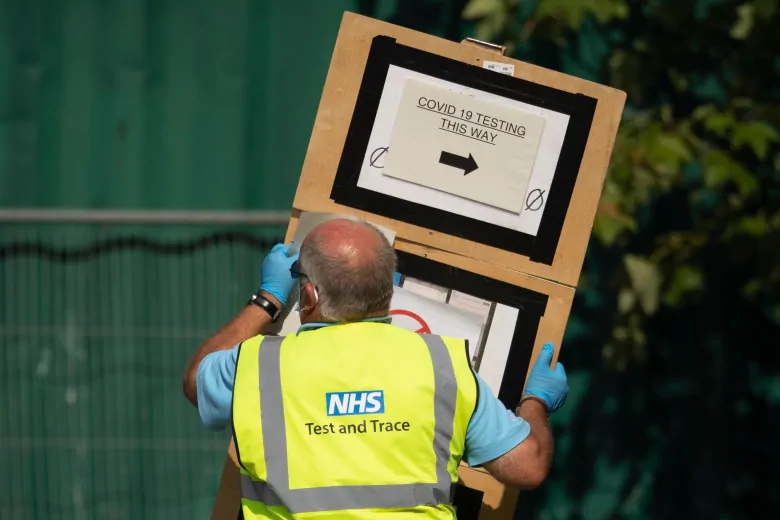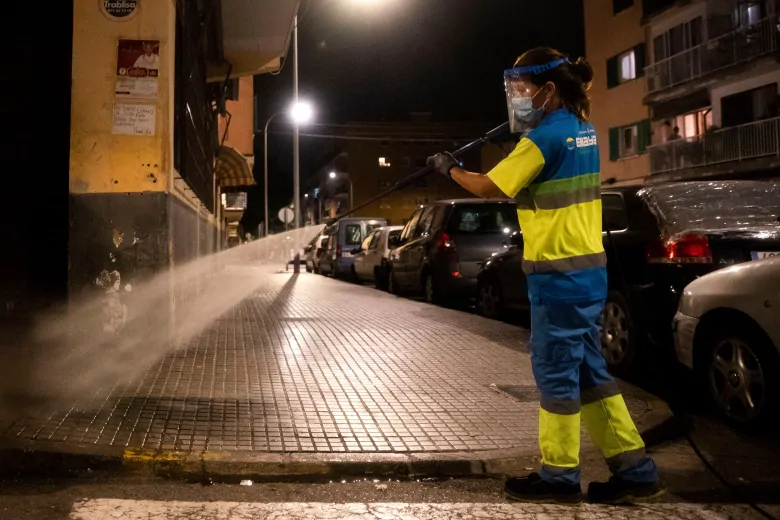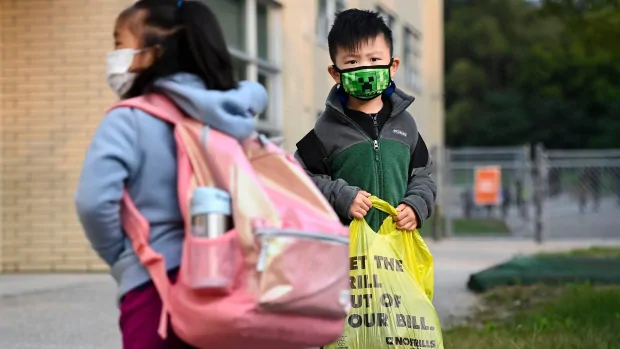The latest:
- Pressure mounts on Health Canada to approve rapid COVID-19 testing devices.
- Ontario premier warns province may move some regions back into lockdown.
- Bloc Québécois leader in isolation after wife tests positive for COVID-19.
- New UN General Assembly president warns unilateralism will only strengthen the pandemic.
- Head of WHO says school closures should be a ‘last resort.’
- Global economy not doing as badly as previously expected: OECD report.
As schools reopen across much of the country, some are voicing concern about the rising number of COVID-19 cases among students and that not enough is being done to protect both children and teachers.
As of 5 a.m. ET on Wednesday, Canada had 138,803 confirmed or presumptive coronavirus cases. Provinces and territories listed 121,840 of those as recovered or resolved. A CBC News tally of deaths based on provincial reports, regional health information and CBC’s reporting stood at 9,230.
The Windsor-Essex Catholic District School Board has confirmed its first student case of COVID-19 at one of its schools, marking the region’s first reported infection in a school.
Stella Maris Catholic Elementary School in Amherstburg was first notified of the diagnosis Tuesday morning, board officials said, and classmates of the COVID-positive student were dismissed through the day and asked to self-isolate for two weeks.
WATCH | The first day of school in a pandemic:
“As soon as we were made aware of the positive case we contacted the health unit, where they worked with the school principal in who would be close contacts,” said Melissa Farrand, the school board’s COVID-19 lead.
Five positive cases of COVID-19 have also been recorded within the Saskatoon school and daycare systems since students began returning to class last week.
“Due to the block scheduling and safety protocols that are currently in place, the SHA has determined the risk to be very low for our school community and there is no evidence of community transmission,” said a letter shared with parents.
Meanwhile, in Hamilton, Ont., educators and their unions are becoming increasingly worried about what they say is a large number of students not wearing masks in local public schools.

Jeff Sorensen, president of the Hamilton-Wentworth Elementary Teachers’ Local, told CBC News there are complaints coming from staff at schools, with one school apparently reporting 25 per cent of students not wearing masks.
Families can opt out of mandatory masking in Hamilton schools if their children have medical issues that would prevent them from using a face covering or mask or have difficulty breathing in one. But they don’t need to provide any proof.
“It’s alarming,” Sorensen said.
Internationally, the head of the World Health Organization (WHO) said closing schools again should be a “last resort” and only applied in places with high levels of transmission.
Tedros Adhanom Ghebreyesus touted the importance of keeping schools open, when possible, and warned that the more kids are out of school, the less likely they are to return in many places.
“Distance learning” should be available where possible, Tedros said.
WATCH | COVID-19: What to do with masks at recess?
In Canada, the transition to virtual schooling has not been a smooth one, with issues like parents feeling left in the dark, postponements, enrolment lists in flux and technical hiccups.
“I have zero faith that [schools are] organized…. The feeling I get is that they don’t have a plan, they’re not prepared,” said Ashley St John, a Toronto mother of a blended family of five children between the ages of two months and 12 years.
Parents in Calgary are also decrying a lack of key information and details about the Calgary Board of Education’s Hub online learning program, which was slated to begin as early as Monday.
“We just don’t have any information as to what time we need to be home and in front of our computers to be able to let the kids connect with their teachers,” said Tamara Rose, who is working from home full time due to multiple autoimmune diseases.
What’s happening around the rest of Canada
In Quebec, the wife of Bloc Quebecois Leader Yves-Francois Blanchet said she is in self-isolation after testing positive for COVID-19.
In a tweet, Nancy Deziel said she was tested Monday after losing her sense of smell.
Deziel said she and those close to her will be in isolation until next Tuesday. She’s continuing to work remotely as a scientist and city councillor in Shawinigan, Que.
Blanchet himself, along with the Bloc Quebecois caucus, was already in isolation as a precaution, after a member of his staff tested positive Monday.
Prime Minister Justin Trudeau’s wife, Sophie Gregoire Trudeau, tested positive for COVID-19 early in the pandemic but has recovered.
Premier Doug Ford said he will introduce new guidelines for COVID-19 hot spots in Ontario in the coming days.
Ford said he has spoken with the mayors of Toronto, Brampton and Ottawa — cities that have seen the bulk of the new COVID-19 cases in recent weeks — about their needs.
On Monday, Ford warned that Ontario’s rising virus rates could force the province to move some regions back into lockdown.
Toronto reported 73 new COVID-19 cases yesterday. There were also 51 in Ottawa and 42 in Peel Region.
With a sudden spike in cases prompting more people to get tested, Canadians are coping with hours-long lineups at COVID-19 testing centres across the country — and some medical experts are calling on Health Canada to approve new devices to deliver faster results.
WATCH | 2nd wave of COVID-19 coming, Ford says:
Concerned parents and their children faced four-hour waits at Ottawa’s primary testing facility on Monday. A similar scene greeted those looking for a test on Tuesday. At Toronto’s William Osler drive-thru testing centre, residents were kept waiting for more than three hours.
Dr. Theresa Tam, Canada’s chief public health officer, said Tuesday that one approach to the crush of people looking for tests could be the deployment of rapid-testing devices. Seven months into this pandemic, these devices still are not available for use in Canada because Health Canada regulators haven’t yet approved them.
“I totally agree with a number of comments from experts that we need to augment the portfolio of testing capabilities in Canada,” Tam told a press conference.
Health officials in Ottawa are urging people who don’t have symptoms or have not been referred to stop clogging up test sites.
There have been what they’ve described as record-breaking lines at testing centres recently as the city’s positive tests surge to levels not seen since early May.
Officials say most people coming for testing don’t need to be there, which is causing a backlog.
“Most simply [get tested] if you have symptoms or you’ve been referred by public health,” said Vera Etches, Ottawa’s medical officer of health, in a news conference Tuesday.
What’s happening around the world
The new president of the United Nations General Assembly is warning that unilateralism will only strengthen the COVID-19 pandemic and is calling for a new commitment to global co-operation including on the fair and equitable distribution of vaccines.
Turkish diplomat and politician Volkan Bozkir, who took over the reins of the 193-member world body on Tuesday, announced that the General Assembly will hold a high-level special session on the COVID-19 pandemic in early November, though diplomats said the date may slip.
Bozkir told diplomats from UN member nations, seated at physically distanced spaces in the assembly chamber, that “no state can combat this pandemic alone,” and it is the members’ responsibility “to strengthen people’s faith in multilateral co-operation and international institutions, with the UN at their centre.”

Spain’s official death toll for the coronavirus surpassed 30,000. The total cases increased beyond 600,000, as Spain became the first European country to reach that threshold.
The Health Ministry added 9,400 new confirmed infections to the total and 156 deaths.
The country has been experiencing one of Europe’s steepest second curves of contagion, with new cases increasing since mid-July. More than half of the newly infected didn’t develop symptoms and are mostly between 20 and 60 years old who didn’t end up requiring treatment.
Amid growing anger over a bottleneck in the United Kingdom’s creaking coronavirus testing system, the government promised on Wednesday to do whatever it takes to boost laboratory capacity, which has left people across the land with no way to get a COVID-19 test.
In an attempt to slow one of the highest coronavirus death tolls in the West, Prime Minister Boris Johnson promised in May to create a “world-beating” system to test and trace people exposed to the virus.

But repeated attempts by Reuters reporters to get COVID-19 tests failed, while at a walk-in testing centre at Southend-on-Sea in eastern England, hundreds of people were queuing to get a test — some from as early as 5 a.m. GMT.
“Laboratory capacity has been an issue. We are working our way through that,” Justice Secretary Robert Buckland told Sky News.
The global economy is not doing as badly as previously expected, especially in the U.S. and China, but it has still suffered an unprecedented drop due to the coronavirus pandemic, an international watchdog said Wednesday.
The Organization for Economic Cooperation and Development said in a report that the world’s gross domestic product is projected to decline by 4.5 per cent this year — less than the six per cent plunge the OECD had predicted in June.
WATCH | Long wait times for COVID-19 test ‘alarming,’ says respirologist:
The global economy is expected to rebound and grow by five per cent next year, the organization said.
Yet the OECD notes that its outlook is “subject to considerable uncertainty” as the pandemic continues, and assumes that “sporadic local outbreaks will continue” and that a vaccine will not be available until late in 2021.

Devoted web advocate. Bacon scholar. Internet lover. Passionate twitteraholic. Unable to type with boxing gloves on. Lifelong beer fanatic.





